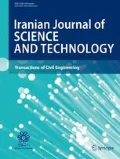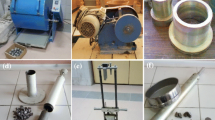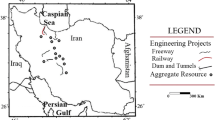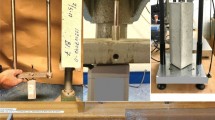Abstract
Infrastructure development projects in Oman are at a peak which results in a huge requirement for the construction materials. Aggregates are one of the most common materials naturally available and used in both cement and asphalt concrete apart from being used as under laying material. The evaluation of aggregates physical, chemical and mechanical properties thus becomes important as it directly affects the product in which they are used as a constituent. Aggregates should be hard and tough enough to resist crushing, degradation and disintegration from any associated activities including manufacturing, stockpiling, production, placing and compaction. In this article, an attempt is made to develop a modified method to determine the abrasion resistance of aggregates. Different sizes of aggregates obtained from two natural sources in Oman were tested in the laboratory using both the standard and modified Los Angles Abrasion (LAA) test, and a mathematical relationship is developed. Based on this relationship, the standard LAA value can be determined from the modified method results. In the modified LAA test method, the time required for the test is reduced by 24 h, apart from reducing the resources required for the test. Since the modified LAA method is developed considering Oman climatic and geological conditions, there is a possibility that this method and mathematical relationship may not be valid in a region when these conditions are changed. In such satiation, the modified LAA test method and mathematical relationship described in this article may need to be validated before it is adopted.
Similar content being viewed by others
1 Introduction
Construction is a major industry providing jobs to millions of people and contributing to the countries and the world economy. Construction industry’s contribution towards the Omani economy is around 9% of the total gross domestic product and employs 18% of the total population (Umar et al. 2018). The ongoing and planned construction projects in Oman for the financial year 2015–2016 amount to a total value of US $43.160 billion (Umar 2016). This includes the largest project “Oman Rail”, which is in the pre-execution phase with a total length of 2135 km and a budget of US$15.6 billion. The ongoing and planned infrastructures projects reflect a large demand for construction materials. Cement production capacity in Oman currently stands at 8.81 Megaton/year (GB 2016). This can be translated to the requirement of aggregates for cement concrete which will be equal to 52.86 Megaton/year. A more or less similar quantity of aggregates would be required for asphalt concrete. A report published by the Ministry of Transport and Communication, Oman indicates that the asphalt road network in Oman has grown exponentially in recent decades, soaring from 3766 km in 1990 to 13,209 km in 2013, an increase of 11 per cent annually. The graded road network also grew significantly during the same period, climbing from 13,048 km in 1990 to 16,600 km in 2013, an increase of 1.2 per cent annually (MOTC 2015). This can be translated to an annual increase in aggregates requirement for highway sector in Oman which is roughly equal to 10%. The infrastructure projects in other gulf countries are also at peak these days. All these projects need an increased quantity of construction materials which results in sustainability issues. Sustainability in a number of areas in the gulf region is comparatively lower than other countries around the world (Umar and Egbu 2018a).
Aggregates are one of the most common materials used in engineering and infrastructure projects. Roughly, both fine and coarse aggregates accumulate more than 85% of cement and asphalt concrete. The accumulative percentage of aggregates used in underlying layers is more than 90%. Aggregates can be obtained from natural sources like gravel pit, river bed and rocks (Umar and Wamuziri 2016; Mamlouk and Zaniewski 2018). Aggregates are exposed to a variety of physical and chemical influences depending on the areas in which they are used. An aggregate should generally be hard, durable and uniform and clean, as well as highly abrasion resistant (Teymen 2017). The aggregates are tested in the laboratory to ascertain their properties. Roberts et al. (1991) noted that aggregates undergo substantial wear and tear throughout their life. The aggregates used in both building and highway projects must be able to transmit loads from top layers to the lower layer of earth surface. Mechanical properties are especially critical for open- or gap-graded hot mix asphalt (HMA), which does not benefit from the cushioning effect of the fine aggregate and where coarse particles are subjected to high contact stresses (Kandhal and Parker 1998). Aggregates which fail to resist abrasion and polishing may cause premature structural failure and a possibility of loss of skid resistance. Poor resistance to abrasion can produce excessive dust during HMA production which results in environmental problems as well as mixture control problems (Wu et al. 1998). The LAA test measures the degradation of a coarse aggregate sample that is placed in a rotating drum with steel spheres. As the drum rotates, the aggregate degrades by abrasion and impact with other aggregate particles and the steel spheres (called the “charge”). Once the test is complete, the calculated mass of aggregate that has broken apart to smaller sizes is expressed as a percentage of the total mass of aggregate. The lower Los Angeles Abrasion loss values indicate aggregate that is tougher and more resistant to abrasion. This article presents the results of LAA tests conducted on different grades of aggregates obtained from a local source of gravel pit in Oman. The aggregates of different grades were tested with the standards procedure, wherein the aggregates were first washed and then dried out at 110o C. The same grades of aggregates were then tested following the standard procedure, but without washing and drying. The aim of this experimental study was to compare the results of LAA test conducted on the different grades of aggregates obtained from a local source of gravel pit and to compare the results of test following both the standard and modified methods.
2 Standard and Modified LAA Test
The standard LAA test referred in this article is conducting the test in accordance with the procedure defined in AASHTO T 96-02, ASTM C131/C131M–14 and ASTM C535–16. The standard procedure of the test indicates that the test samples need to be separated into individual size fractions and recombined to the grading as shown in Table 1 (ASTM 1994, C131-81); AASHTO T 96-02). The sample of the aggregates shown in Table 1 needs to be collected from washed aggregate dried at 110 ± 5 °C (230 ± 9 °F). The abrasive charge and number of revolutions depend upon the grading of the test sample as described in Table 2. In the LAA, as the drum rotates, a shelf plate picks up the sample and the steel spheres, carrying them around until they are dropped to the opposite side of the drum, causing an impact-crushing effect. The contents then roll within the drum with an abrading and grinding action until the shelf plate impacts, and the cycle is repeated. In the standard Los Angeles Machine, the drum normally rotates at a speed of 30–33 revolutions per minute. After the prescribed number of revolutions, the contents are removed from the drum and the aggregate portion is sieved to measure the degradation as percentage loss. After the prescribed number of revolutions, the material is discharged from the machine and a preliminary separation of the sample is made on 4.75-mm sieve. The fine material portion is sieved on a 1.7-mm sieve. Aggregates coarser than the 1.70 mm are washed, oven dried at 110 ± 5 °C and weighed to the nearest gram. Washing the aggregates over a 1.70-mm sieve and re-drying are normally only required when the percentage loss is within 2% of the specification limit. The test has more acceptability because the resistance to abrasion and impact is determined simultaneously. Depending upon the percentage loss value, the suitability of aggregates for different layers of road constructions can be judged as per Ministry of Transportation and Communication, Oman, specifications given in Table 3. Mathematically, the percentage loss in the weight of aggregates after performing the test can be obtained from Eq. (1).
where X = weight of the sample in grams before testing, Y = weight of the sample after testing and Z = weight Loss in grams (X − Y).
The standard LAA test required approximately 25 h. The time required for each component of the test is shown in Table 4.
Modified LAA test referred in this article is conducting the test as per the procedure mentioned in the standard LAA test expects washing and drying the aggregates at 110 ± 5 °C before and after the test. This method is adopted to observe the variation in the results of aggregates obtained from a specific source (gravel pit) in Oman. The hypothesis behind adopting this procedure is that although the results obtained from standard and modified would not be the same, if the results in both cases would be in the range of acceptable range, then the stages of washing and drying the aggregates can be waived from the standard procedure of LAA test. This will help to establish a relationship between the results obtained from both methods. There is a possibility that modified LAA test will best suit the aggregates obtained from Oman due its climatic conditions and crust properties.
The LAA test was developed considering the US environmental conditions. However, in the gulf region particularly, Oman, environmental conditions are totally different from the USA. The average maximum reported temperature in July 2017 was 39 °C, while the average rainfall in the same period was 0.4 mm (WWO 2017). It needs to be noted that the actual temperature in the summer season in Oman is far more than the reported one. Umar and Egbu (2018b) quoting some local newspapers reported that in summer, the maximum temperature could reach to 50 °C in some parts of Oman. The summer period in Oman usually remains 8 months of the year covering the period from March to October. Both the high climatic temperature and low rainfall in Oman could have an impact on the aggregates and somehow raise concerns about the washing and drying of the aggregates for LAA test. This also supports the argument that if there is to be any impact on the result of LAA value of the aggregates, it would be much less and may have no practical implication. If the argument is supported by the laboratory experiments results, then it can lead towards reducing the two steps: washing and drying of aggregates for LAA test in Oman. This will not only reduce the time required for the testing, but will also reduce the use of resources and energy to conduct such tests.
3 Laboratory Experiments
The samples of aggregates for laboratory experiments were obtained from two gravel pit sources of aggregates. The aggregates from these sources were in use in the construction of a local highway project connecting two cities of Oman with an estimated cost of US $305.90 million and a length of 75 km. Overall, in this project, aggregates from five different locations were used. The reason for obtaining aggregates from two different locations was that at each location different sizes of aggregates were available. At the first location of aggregate source, the size of aggregates available was from the range of 2.35 mm to 37.5 mm and at second location of source, the aggregates size was from 25 mm to 75 mm. Thus, aggregates of grades A, B, C and D were obtained from the first source and aggregates of grade E, F and G were obtained from the second source. The AASTTO (T2) and ASTM (D75/D75M–14) standards which cover the sampling of both coarse and fine aggregates were used to collect the appropriate field samples of aggregates. The test samples for different grading of aggregates were prepared in accordance with criteria mentioned in Table 1 (ASTM 1994, C131-81). Measuring balance (weighting scale) with a readability of 0.5 g was used to measure the mass of each sample. The LAA machine used for the testing was also in compliance with European Standards CSN EN 1097-2 (2010). Large capacity oven with a temperature control from 40 to 250 °C was used where the samples were required to be oven dried. Two samples of each grade were prepared. The first sample of each grade was tested according to the standard LAA test procedure, and the second sample was tested according to the modified method of LAA method. The modified LAA test is similar to the standard LAA method; however, in the modified LAA method, the washing and drying of aggregates were ignored. Equation (1) is used to determine the percentage loss in each sample. The test results obtained from both methods are reported in Table 5.
4 Interpretation of Results and Discussion
The results of standard and modified LAA test show that in both cases, the results are different; however, after comparing with the maximum values as shown in Table 3, they are in the acceptable range if used in the construction of highways. The results indicate that the values of LAA test performed on different sizes of aggregates are not the same using a standard method or modified method. For instance, aggregates of grading A, B, C and D are obtained from the same source of aggregates; however, the percentage loss in all cases is different, which reveals that the LAA values are more dependent on the size of aggregates rather than the geological nature of aggregates. Comparatively, aggregates from the second source which has grading of E, F and G give a lower value of percentage loss by both standard and modified method which indicates that aggregates from the second source have a higher abrasion resistance. Comparing both the results of LAA values obtained through a standard method and modified method encourages the argument that since the values obtained are in the acceptable range, there is a possibility of skipping two components of the test which is washing and drying of aggregates. This can reduce the time required by 24-h interval from reducing the resources required for the standard test. The typical time required for a standards LAA test is approximately 25 h (Table 4). The results of modified LAA test can be translated to the standard test. For instance, the aggregates of grading “A” give a percentage loss in weight equal to 21.76%, while the percentage loss through the standard LAA test is equal to 23.17%. Mathematically, the relationship between two results can be developed through Eq. (2) as under.
where N = modification factor, X = percentage loss through standard Los Angeles Abrasion test and Y = percentage loss through modified Los Angeles abrasion test.
Using Eq. 2, the modification factor (N) for aggregates of grading A will be equal to 0.958. The standard LAA can be obtained by using Eq. 3 as under.
where SLA = standard LAA value, MLA = modified LAA value and N = modification factor [calculated from Eq. (2)].
The calculated Los Angeles Abrasion value for aggregates grading “A” using Eq. 3 is equal to 23.17% which is the same value obtained from the standard LAA test (Table 6). Based on these equations, the modification factors (N) and the values of percentage loss for all grading of aggregates are calculated and presented in Table 6. These modification factors (N) can be used whenever the modified LAA test is used, and it is required to determine the standard value of LAA value.
The results of standard and modified LAA test shown in Table 5 are not consistent, which reflects that even if the aggregates source is the same, the Los Angeles Abrasion value can be different. This indicates that there is a major role of the size of aggregates which is one of the main factors which control the Los Angeles Abrasion value. The procedure mentioned above for the calculation of standard Los Angeles Abrasion value from modified Los Angeles Abrasion value will be valid for the aggregates from the same sources; however, as the source aggregates will change, their standard and modified LAA values will change, and this will change the modification factors. For instance, the aggregates from river bed and rocks will have different values for Los Angeles Abrasion. Thus, it is recommended that appropriate validation needs to be done before considering the use of modified method for Los Angeles Abrasion test. It is also necessary to keep in mind that as the earth crust properties change, the aggregates properties will change. The aggregates used in these experiments were from two sources approximately 10 km away from each other, and there is a considerable variation in the values of Los Angeles Abrasion obtained through standard and modified method. The research is conducted in a specific area in Sultanate of Oman, which has its own geological facts. Therefore, apart from crust and upper plate’s properties of the earth, temperature variation and rainfall could be some of the factors which need to be considered before adopting modified method of Los Angeles Abrasion.
5 Conclusion
Aggregates are one of the main and important construction materials which are used very widely. Aggregates can be obtained from natural sources such as gravel pit, river pit and rocks. Physical, chemical and mechanical properties of aggregates and their effective evaluation are considered important as it influences the final product such as cement or asphalt concrete properties. There are several laboratory and field tests which help researchers to understand aggregates properties and to decide on the use of aggregates for a specific mix design. In this article, the abrasion resistance of aggregates is considered and an attempt is made to develop a time-effective method for determining the LAA value. Aggregates obtained from two sources in Oman are tested through a standard and modified LAA method, and a relationship between both methods is developed. The standard LAA test normally required 25 h for one test, while in modified method the duration of the test can be reduced by 24 h apart from reducing the resources required for a standard LAA test. Considering the high temperature and low rainfall in Oman, two main components from standard LAA test which are washing and drying of aggregates are skipped from the modified LAA test. The results from both standard and modified LAA test were, however, not the same, but were in the acceptable range if used in the highway construction. To calculate the standard LAA value from the modified LAA results, a mathematical relationship is developed and a modification factor is obtained for different grades of aggregates. The modified LAA test and the mathematical relationship with standard LAA discussed in this article may only be valid in Oman and other gulf countries as the temperature, rainfall and earth crust and upper plate’s properties are similar. In a situation where these factors are changed, the modified Los Angeles results and its relationship with the standard LAA results will change, and it will require validation before the modified LAA test is adopted. The results obtained from both standard and modified LAA are limited to two locations and the same source (gravel pit) of aggregates. It is possible that the results from a different source of aggregates such as river bed or rocks would be different, and the modification factors may need to be calculated. Thus, further research is recommended to investigate the topic, further considering the other source of aggregates and finding similar modification factors which could be applicable in different situations. Since this was an initial attempt to develop a modified LAA test, the laboratory experiments were on a limited scale. One standard and one modified test for each grade of aggregates were conducted. In further research, the number of tests may need to be more to increase the reliability of the results.
References
AASHTO T 96-02 (American Association of State Highway and Transportation Officials) Standard method of test for resistance to degradation of small-size coarse aggregate by abrasion and impact in the Los Angeles Machine. 2002. AASHTO, Washington, USA. http://standards.globalspec.com/std/1021272/aashto-t-96. Accessed 08 Nov 2017
AASTTO (T2) (American Association of State Highway and Transportation Officials) Sampling of Aggregates. AASHTO, Washington, USA. http://www.dot.nd.gov/manuals/materials/testingmanual/t2.pdf. Accessed 19 Nov 2017
ASTM (American Society of Testing and Materials) (1994) C131-81 Standard test method for resistance to degradation of small size coarse aggregate by abrasion and impact in the Los Angeles Machine. 1994 Annual Books of ASTM Standards, Volume 04.03, American Society for Testing and Materials, Philadelphia, PA, USA, pp 19103-1187
ASTM (D75/D75 M–14) (American Society of Testing and Materials) Standard practice for sampling aggregates, 2014. ASTM, ASTM, Pennsylvania, USA. https://www.astm.org/Standards/D75.htm. Accessed 19 Nov 2017
ASTM C131/C131 M–14 (American Association of State Highway and Transportation Officials) Standard test method for resistance to degradation of small-size coarse aggregate by abrasion and impact in the Los Angeles Machine. 2014. ASTM, Pennsylvania, USA
ASTM C535–16 (American Association of State Highway and Transportation Officials) Standard test method for resistance to degradation of large-size coarse aggregate by abrasion and impact in the Los Angeles Machine. 2016. ASTM, Pennsylvania, USA. https://www.astm.org/Standards/C535.htm. Accessed 15 Jan 2017
CSN EN 1097-2 (2010) European standards. Tests for mechanical and physical properties of aggregates—part 2: methods for the determination of resistance to fragmentation. 2010. European Standards Store, Czech Republic
GB (Global Cement) (2016) Update on cement industry of Oman. Global Cement, Surrey, United Kingdom. http://www.globalcement.com/news/itemlist/tag/Oman%20Cement. Accessed 12 Oct 2017
Kandhal PS, Parker F (1998) Aggregate tests related to asphalt concrete performance in pavements (No. 405). Transportation Research Board. Washington, USA. http://pubsindex.trb.org/view/1998/m/477791. Accessed 08 Nov 2017
Mamlouk MS, Zaniewski JP (2018) Materials for civil and construction engineers, 4th edn. Pearson Education Limited, London
MOTC (Ministry of Transport and Communication, Oman) (2010) Highway Design Standards, Standard Specifications for Road and Bridge Construction. Ministry of Transport and Communication, Oman, 2010. vol 3. Muscat, Oman
MOTC (Ministry of Transport and Communication, Oman) (2015) Special Issue on Roads in Oman. Ministry of Transport and Communication, Oman, March, 2015. Issue 2. Muscat, Oman. http://www.motc.gov.om/Ann/2015En/index.html#/18. Accessed 06/12/2017
Roberts FL, Kandhal PS, Brown ER, Lee DY, Kennedy TW (1991) Hot mix asphalt materials, mixture design and construction
Teymen A (2017) Estimation of Los Angeles Abrasion resistance of igneous rocks from mechanical aggregate properties. Bull Eng Geol Environ. https://doi.org/10.1007/s10064-017-1134-0
Umar T (2016) Cost of accidents in the construction industry of Oman. In: Proceedings of the institution of civil engineers: municipal engineer. 170(2):68–73. Thomas Telford Ltd. https://doi.org/10.1680/jmuen.16.00032
Umar T, Egbu C (2018a) Global commitment towards sustainable energy. In: Proceedings of the institution of civil engineers-engineering sustainability. Thomas Telford Ltd., pp 1–09. https://www.icevirtuallibrary.com/doi/abs/10.1680/jensu.17.00059
Umar T, Egbu C (2018b) Heat stress, a hidden cause of accidents in construction. In: Proceedings of the institution of civil engineers–municipal engineer. Thomas Telford Ltd., pp 1–30. https://www.icevirtuallibrary.com/doi/abs/10.1680/jmuen.18.00004
Umar T, Wamuziri S (2016) Strength Analysis of Concrete (300/20) with Super plasticizer. In: Mohammad M (ed) Proceeding of the international conclave on innovations in engineering & management (Oman Vision 2020: Opportunities & Challenges). 24–25 Feb 2016. Muscat, Oman. pp 162–176. ISBN:978-99969-0-773-9. https://www.waljatcollege.edu.om/downloads/SouvenirICIEM-2016.pdf
Umar T, Egbu C, Wamuziri S, Honnurvali MS (2018) Briefing: occupational safety and health regulations in Oman. Proc Inst Civ Eng-Manag Procur Law 171(3):1–7
Wu Y, Parker F, Kandhal K (1998) Aggregate toughness/abrasion resistance and durability/soundness tests related to asphalt concrete performance in pavements. NCAT Report 98-4. National Center for Asphalt Technology. Auburn, USA. http://www.eng.auburn.edu/center/ncat/reports/rep98-4.pdf. Accessed 08 Nov 2017
WWO (World Weather Online) (2017) Current Weather Report. World Weather Online. UK. https://www.worldweatheronline.com/muscat-weather-averages/masqat/om.aspx. Accessed: 16/11/2017
Author information
Authors and Affiliations
Corresponding author
Rights and permissions
About this article
Cite this article
Umar, T., Egbu, C. & Saidani, M. A Modified Method for Los Angeles Abrasion Test. Iran J Sci Technol Trans Civ Eng 44, 941–947 (2020). https://doi.org/10.1007/s40996-019-00268-w
Received:
Accepted:
Published:
Issue Date:
DOI: https://doi.org/10.1007/s40996-019-00268-w




